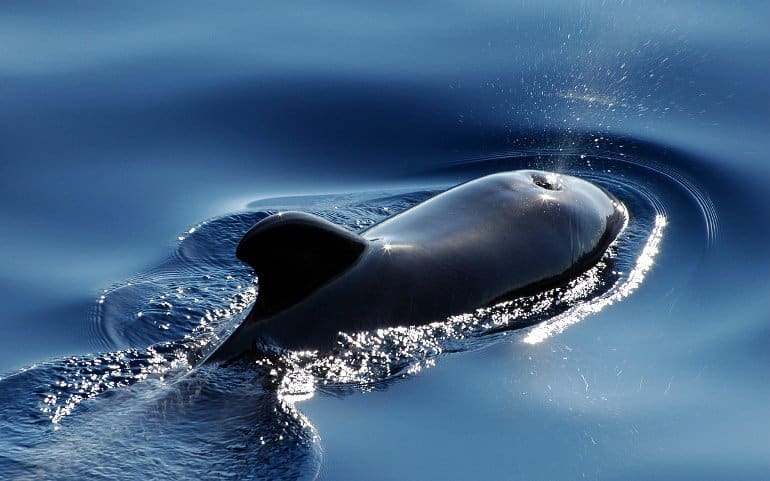Summary: Study reveals specialized blood vessels in the whale brain protect them from pulses in their blood caused by swimming, which could cause brain damage.
Source: University of British Columbia
Special blood vessels in whale brains may protect them from pulses, caused by swimming, in their blood that would damage the brain, new UBC research has suggested.
There are many theories as to the exact use of these networks of blood vessels cradling a whale’s brain and spine, known as ‘retia mirabilia’, or ‘wonderful net’, but now UBC zoologists believe they’ve solved the mystery, with computer modeling backing their predictions.
Land mammals such as horses experience ‘pulses’ in their blood when galloping, where blood pressures inside the body go up and down on every stride.
In a new study, lead author Dr. Margo Lillie and her team have suggested for the first time that the same phenomenon occurs in marine mammals that swim with dorso-ventral movements; in other words, whales. And, they may have found out just why whales avoid long-term damage to the brain for this.
In all mammals, average blood pressure is higher in arteries, or the blood exiting the heart, than in veins. This difference in pressure drives the blood flow in the body, including through the brain, says Dr. Lillie, a research associate emerita in the UBC department of zoology.
However, locomotion can forcefully move blood, causing spikes in pressure, or ‘pulses’ to the brain. The difference in pressure between the blood entering and exiting the brain for these pulses can cause damage.
Long-term damage of this kind can lead to dementia in human beings, says Dr. Lillie. But while horses deal with the pulses by breathing in and out, whales hold their breath when diving and swimming.
“So if cetaceans can’t use their respiratory system to moderate pressure pulses, they must have found another way to deal with the problem,” says Dr. Lillie.
Dr. Lillie and colleagues theorized that the retia use a ‘pulse-transfer’ mechanism to ensure there is no difference in blood pressure in the cetacean’s brain during movement, on top of the average difference.
Essentially, rather than dampening the pulses that occur in the blood, the retia transfer the pulse in the arterial blood entering the brain to the venous blood exiting, keeping the same ‘amplitude’ or strength of pulse, and so, avoiding any difference in pressure in the brain itself.
The researchers collected biomechanic parameters from 11 cetacean species, including, fluking frequency, and input these data into a computer model.

“Our hypothesis that swimming generates internal pressure pulses is new, and our model supports our prediction that locomotion-generated pressure pulses can be synchronized by a pulse transfer mechanism that reduces the pulsatility of resulting flow by up to 97 percent,” says senior author Dr. Robert Shadwick, professor emeritus in the UBC department of zoology.
The model could potentially be used to ask questions about other animals and what’s happening with their blood pressure pulses when they move, including humans, says Dr. Shadwick. And while the researchers say the hypothesis still needs to be tested directly by measuring blood pressures and flow in the brain of swimming cetaceans, this is currently not ethically and technically possible, as it would involve putting a probe in a live whale.
“As interesting as they are, they’re essentially inaccessible,” he says. “They are the biggest animals on the planet, possibly ever, and understanding how they manage to survive and live and do what they do is a fascinating piece of basic biology.”
“Understanding how the thorax responds to water pressures at depth and how lungs influence vascular pressures would be an important next step,” says co-author Dr. Wayne Vogl, professor in the UBC department of cellular and physiological sciences. “Of course, direct measurements of blood pressure and flow in the brain would be invaluable, but not technically possible at this time.”
About this neuroscience research news
Author: Alex Walls
Source: University of British Columbia
Contact: Alex Walls – University of British Columbia
Image: The image is in the public domain
Original Research: Closed access.
“Retia mirabilia: Protecting the cetacean brain from locomotion-generated blood pressure pulses” by Robert Shadwick et al. Science
Abstract
Retia mirabilia: Protecting the cetacean brain from locomotion-generated blood pressure pulses
Cetaceans have massive vascular plexuses (retia mirabilia) whose function is unknown. All cerebral blood flow passes through these retia, and we hypothesize that they protect cetacean brains from locomotion-generated pulsatile blood pressures.
We propose that cetaceans have evolved a pulse-transfer mechanism that minimizes pulsatility in cerebral arterial-to-venous pressure differentials without dampening the pressure pulses themselves.
We tested this hypothesis using a computational model based on morphology from 11 species and found that the large arterial capacitance in the retia, coupled with the small extravascular capacitance in the cranium and vertebral canal, could protect the cerebral vasculature from 97% of systemic pulsatility.
Evolution of the retial complex in cetaceans—likely linked to the development of dorsoventral fluking—offers a distinctive solution to adverse locomotion-generated vascular pulsatility.






